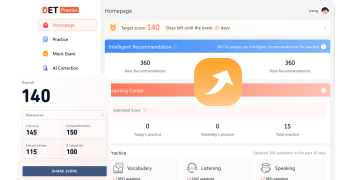Mastering the ‘Read, Then Write’ Challenge in the Duolingo English Test
Welcome, English language enthusiasts and Duolingo English Test aspirants! Today, we delve into the ‘Read, Then Write’ section of the DET, a pivotal part of the exam that gauges your ability to understand and produce written English effectively. Many find this section daunting due to its time constraints and the depth of response required. Fear not! This post is your strategic guide to not only approach this section with confidence but also to master it.
The ‘Read, Then Write’ task presents you with a prompt to which you’ll craft a response in 5 minutes. Sounds challenging, right? But with the right approach, you can turn this challenge into an opportunity to showcase your English proficiency. Whether you’re a seasoned English speaker or a language learner, this guide will offer you practical strategies, time management tips, and even response templates to ensure your success. So, let’s embark on this journey together and transform your writing from good to great!
Stay tuned for insightful tips on understanding prompts, structuring your responses, enriching your vocabulary, and much more, complete with adaptable templates to steer your practice in the right direction. Are you ready to ace the ‘Read, Then Write’ section? Let’s get started!

1. Understanding the Prompt: The Key to a Targeted Response
Diving into the ‘Read, Then Write’ section begins with one crucial step: comprehending the prompt. This section demands not just your linguistic skills but also your analytical acumen. Here’s how to ensure you’re on the right track:
Firstly, dissect the prompt. Break it down into its fundamental components. What is the main topic? Are there any specific details or comparisons asked for? Identifying these elements is essential for a relevant response.
Secondly, pinpoint the question type. Is it asking for a descriptive response where you illustrate ideas with examples, or is it an argumentative one where you take a stance? Your approach will hinge on this distinction.
Lastly, pay attention to directive words. Words like ‘describe,’ ‘compare,’ or ‘argue’ give you direct insight into what the examiners are looking for. Ignoring these could lead you down the wrong path.
Take, for instance, the prompt: “Talk about the last time you felt scared to do something new, but you did it anyway. How did you find the strength to try it? What did you learn from this experience that will help you in life?“
To dissect this, identify the three key components: a personal experience of fear, the overcoming of that fear, and the life lesson learned. It’s descriptive but also reflective, requiring not just a recounting of an event but also personal insight.
Pinpoint the action words: talk,’ ‘found the strength,’ and ‘learned.’ These direct you to share a narrative, reflect on your inner resilience, and extrapolate a broader life lesson.
Remember, such a prompt isn’t just asking for what happened. It’s inviting you to narrate a journey and reflect on its impact. By fully understanding this, your response will not only recount a story but also offer a glimpse into your personal growth, perfectly aligning with what the prompt seeks.
Remember, the prompt is your roadmap; understanding it is not just the first step—it’s the foundation of a compelling response that will resonate with the evaluators. So, take a moment, read it carefully, and let clarity guide your pen!
2. Time Management Mastery:
Mastering time management is critical when you have only five minutes to respond. Here’s a strategic breakdown:
Plan Quickly: Spend a minute brainstorming and outlining. Jot down your ideas and the points you want to make.
Write Efficiently: Allocate three minutes to writing. Stick to your outline and keep sentences concise. Aim for clarity and precision.
Proofread Effectively: Reserve the final minute for proofreading. Check for grammatical errors, ensure you’ve answered all parts of the prompt, and refine any awkward phrasing.
By structuring your time wisely, you ensure that your response is coherent, clean, and complete. Remember, a polished answer within the time limit is better than an unfinished masterpiece.
3. Structuring Your Response: Keep It Simple and Clear
With only 5 minutes for the ‘Read, Then Write’ section, simplicity is key. Here’s how to structure a clear and effective response:
Introduction: Begin with a straightforward sentence that addresses the prompt directly. If the prompt is about a personal experience, start with a concise statement that sets the scene.
Main Body: Pick one or two main points to develop. If you’re describing an experience, focus on the most impactful part. If you’re arguing a point, state your main reason and briefly support it.
Conclusion: End with a short closing that reflects on the experience or reiterates your point. Make it resonate but keep it succinct.
This simple structure ensures that your response is organized and that you remain focused on the prompt, making the most of the limited time.
With the prompt “Talk about the last time you felt scared to do something new, but you did it anyway. How did you find the strength to try it? What did you learn from this experience that will help you in life?“, let’s
demonstrate a straightforward structure:
Introduction: “Facing my long-standing fear of heights, I decided to try rock climbing, an activity that both terrified and intrigued me.”
Main Body: “Initially, the very thought of climbing filled me with dread. However, recognizing the importance of confronting my fears, I started with small, manageable climbs. I sought guidance from experienced climbers and gradually built my confidence through their support and my persistent practice. This journey was not just about climbing but about learning to trust in my abilities and the support of those around me. The moment I reached the top of my first significant climb, the overwhelming sense of achievement eclipsed any fear I had felt.”
Conclusion: “This experience taught me that facing fears head-on, with preparation and support, can lead to profound personal growth.”
This example sticks to the simple structure of the introduction, body, and conclusion, fitting a coherent and impactful response into a concise format suitable for the 5-minute writing task.
4. Depth Over Breadth: Crafting Rich Responses
Focusing on depth rather than trying to cover too much is vital for the ‘Read, Then Write’ section. This means choosing one or two key points and exploring them in detail. Use specific examples and personal insights to provide a rich, nuanced response. This approach not only demonstrates your ability to think critically and reflectively but also ensures that your writing is engaging and meaningful. Aim to show a deep understanding of the topic at hand, which will make your response stand out to the evaluators.
5. Language and Vocabulary: The Art of Precision and Variety
Utilizing a varied and precise vocabulary is crucial in the ‘Read, Then Write’ section. Aim to use specific, expressive words that accurately convey your thoughts and emotions. This doesn’t mean resorting to overly complex or obscure terms that might confuse the reader. Instead, strive for clarity and precision in your language choice. Using synonyms thoughtfully can add richness to your text without compromising understandability. Additionally, correct grammar and sentence structure are essential to communicate your ideas effectively and make a positive impression on the evaluators.
To refine the response using varied and precise vocabulary, you may consider the following enhancements:
Introduction: “Confronted by my perennial dread of altitudes, I embraced rock climbing, a venture that both daunted and captivated me.”
Main Body: “The notion of ascending vertical faces initially paralyzed me with fear. Acknowledging the necessity to confront my apprehensions, I embarked on modest ascents, under the tutelage of seasoned climbers. Their mentorship, coupled with my steadfast dedication, gradually fortified my confidence. This odyssey was not merely about climbing; it was an expedition in self-discovery and trust. Achieving the summit of my inaugural significant climb was a testament to surmounting fears through perseverance and communal support.”
Conclusion: “This odyssey illuminated the essence of bravery, tenacity, and the significance of stepwise progression. It underscored that engaging directly with one’s fears, equipped with preparation and camaraderie, catalyzes profound self-evolution. These lessons serve as invaluable compasses for navigating future adversities with a fortified resolve.”
This version leverages a richer vocabulary and more descriptive language to convey the experience vividly and reflectively, showcasing how precise language choice enhances the narrative’s depth and impact.
6. Templates for Success: Structured Approaches for Different Question Types
To effectively approach ‘Read, Then Write’ questions, consider these simple templates tailored for both descriptive and argumentative prompts:
Descriptive Prompt Template:
- Introduction: Briefly introduce the situation or experience.
- Body: Describe the experience with specific details, focusing on sensory information and emotions to bring the story to life.
- Conclusion: Reflect on the experience, emphasizing personal growth or insights gained.
Argumentative Prompt Template:
- Introduction: State your position clearly.
- Body: Present one or two strong arguments supported by examples or evidence.
- Conclusion: Reinforce your stance, summarizing how your arguments support your position.
These templates serve as blueprints to construct clear, focused responses. Remember, customization based on the prompt is key to delivering a compelling answer.
7. Proofreading Practices: Enhancing Quality through Attention to Detail
Proofreading is the final, crucial step in ensuring your ‘Read, Then Write’ response shines. This stage is not just about hunting for typos; it’s a comprehensive review to enhance clarity, coherence, and impact. Allocate at least one minute for this process, following these steps:
1. Check for Completeness: Revisit the prompt to confirm your response addresses all aspects. Missing a part of the question can significantly affect your score.
2. Grammar and Syntax Review: Look for common grammatical errors such as subject-verb agreement, incorrect use of tenses, and misplaced modifiers. Ensure your sentences flow smoothly and your usage of punctuation enhances readability.
3. Vocabulary and Clarity: Verify that your word choices are precise and appropriate for the context. Replace vague terms with specific ones to add depth to your narrative or argument.
4. Logical Flow: Assess the organization of your ideas. Ensure each paragraph transitions smoothly to the next, maintaining a logical progression of thought.
5. Eliminate Redundancies: Remove repetitive statements or unnecessary words. Conciseness is key to clear and powerful writing.
6. Read Aloud: Hearing your text can uncover awkward phrasings and overlooked errors that silent reading might miss.
7. Final Glance for Spelling: Even with spell check, some mistakes can slip through, especially with homophones or incorrect word choices that are still valid words.
By integrating these proofreading practices, your response will not only be grammatically correct but also more engaging and effective. This meticulous refinement process can elevate your writing, leaving a lasting impression on the evaluators.
Throughout this comprehensive guide, we’ve delved into essential strategies and practical templates to navigate the ‘Read, Then Write’ section of the Duolingo English Test effectively. From decoding prompts with precision to managing your precious five minutes judiciously, structuring responses to highlight clarity and depth, enhancing your narrative with a varied vocabulary, and fine-tuning your draft with diligent proofreading—each strategy plays a pivotal role in crafting a compelling answer. Remember, excellence in this segment stems from persistent practice and thoughtful application of these techniques. I encourage you to integrate these strategies into your preparation routine, refining your skills progressively. Let each practice session be a step towards not just meeting but exceeding your writing goals, propelling you toward success in the DET.
Click here for more DET Preparation Strategies
Look for tips on DET? Find out here: https://www.detpractice.com/category/pro-test-tips/
Start practicing today by signing up for our DET question bank for free.






